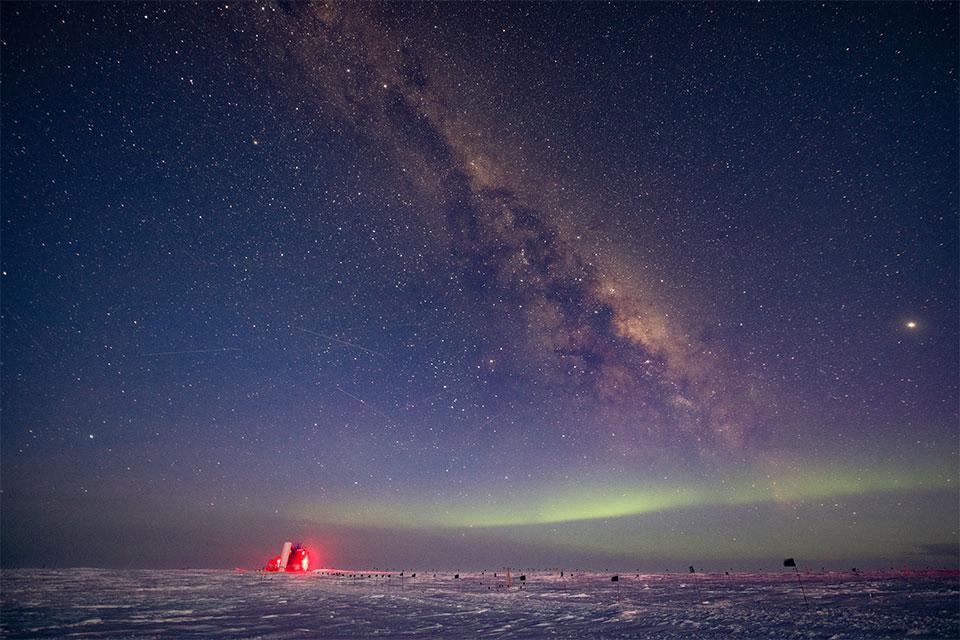The IceCube Neutrino Observatory, an unconventional telescope buried under the South Pole, began full operations 10 years ago on 13 May 2011. Since then, IceCube has been watching the cosmos and collecting data continuously for a decade.
The purpose of the telescope was to detect signals from passing neutrinos: mysterious, tiny, extremely lightweight particles created by some of the most energetic and distant phenomena in the cosmos. IceCube’s founders believed that studying astrophysical neutrinos would reveal hidden secrets of the universe – and they would be proven right.
This ambitious telescope was the result of 7 years of extraordinary work that saw dozens of intrepid technicians, engineers, and scientists travel to the South Pole, one of the coldest, driest, and most isolated places on Earth. Crews drilled 86 holes 2.5 km deep and lowered a cable strung with 60 basketball-sized light detectors into each hole. The result was a hexagonal grid of sensors embedded in a cubic kilometre of ice, about a mile below the surface of the Antarctic ice sheet.
IceCube continues to expand its science reach, providing breakthrough results on astrophysical neutrinos, cosmic rays, and fundamental physics. Funding has been secured for the next stage of the detector, the IceCube upgrade, which will pave the way to the proposed much larger, high-energy extension, IceCube-Gen2.
Prof. Subir Sarkar of the Rudolf Peierls Centre for Theoretical Physics who has been the institutional lead at Oxford since the inception of IceCube says: ‘This is a remarkable collaboration in many ways – not least because theorists like me were invited to join in with the experimentalists … it is our close interaction that maps the way forward!’
Ten things to know about IceCube
- Previous efforts to observe and measure neutrinos in the deep sea via Cherenkov radiation had failed, hence it was decided to try the experiment in the polar icecap.
- Drilling kilometre-deep holes in the icecap did not work either! There were still too many air bubbles. However, the scientists persevered and drilled down over twice as deep … and there the ice was clear enough that the Cherenkov light is not too scattered or absorbed.
- Although construction of IceCube took 7 years, data taking began right from 2004 when the first of 86 strings carrying 60 digital optical modules (DOMs) were lowered into the ice.
- To drill the holes 2.5 km down requires a purpose-built 5 Megawatt hot water drill. Drilling can be done only during the Antarctic ‘austral summer' (November to February) when the Sun is always above the horizon and work can proceed around the clock.
- The signal is digitised inside the DOMs and brought up to the ‘counting house’ on the surface where it is analysed by computers and then transmitted by satellite to IceCube headquarters in Madison, and made available to the collaborators around the world.
- Nearly all of the DOMs embedded in the ice are still working, with an uptime of 99%. This huge experiment can be monitored and operated remotely using just a laptop from anywhere in the world.
- The University of Oxford is the only UK institution which has been a full member of IceCube, right from its inception in 2004. The University of Manchester, Queen Mary, London and King’s College, London are now associate members.
- Over-wintering is usually done by two people who send reports on detector operations every week – along with numerous photographs of the desolate but beautiful Antarctic landscape and the spectacular ‘Southern lights’ that keep them company at temperatures that can drop down (with windchill) to -100 degrees celcius!
- In 2013 IceCube made the first detection of high energy extraterrestrial neutrinos (which Physics World named ‘breakthrough of the year’), and in 2018 identified the first cosmic source of such particles – a flaring ‘blazar’ that is 3.7 billion light years distant.
- IceCube’s recent detection of a Glashow resonance event confirmed a 60-year-old prediction of the Standard Model of physics.
Find out more about life at the Pole.
Find out more about IceCube.

